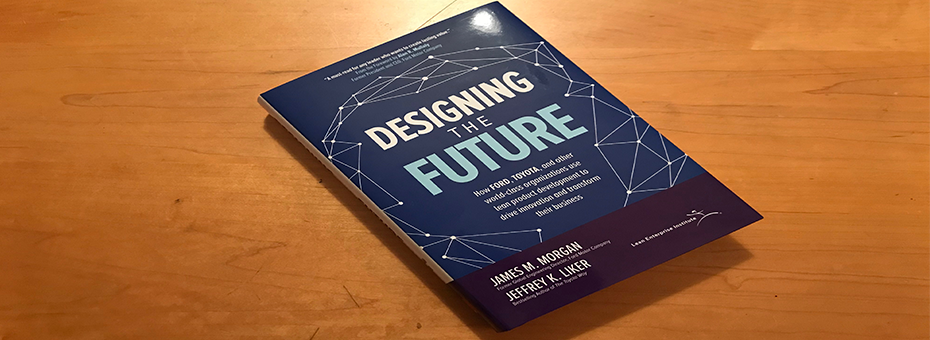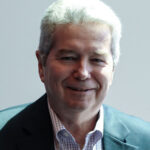In Designing the Future, with a Foreword by former Boeing and Ford CEO Alan Mulally, globally recognized lean development expert Jim Morgan teams up with world-renowned lean management guru Jeff Liker to detail a lean development framework that any company can use to design much better products and services — and a better future for themselves, their customers, employees, and all stakeholders. Here he talks with LEI Communications Director Chet Marchwinski about a proven and fundamentally better way to develop new products and services.
Chet: What business problem will the book help readers solve?
Jim: Well, first off, it was an honor to work with Jeff and everyone else that contributed to this project – I am very grateful. Our goal for the book is to help organizations improve their product and process capability. Whether you are designing a physical product, a service or even a clinical process it is one of the most important activities an organization can engage in. When you develop new products, you not only have the opportunity to create differentiating innovation, but you’re also having a major impact on your operating costs and your quality potential. Great development provides the foundation for excellence in operations. So the decisions that you make during the development process will impact your organization for years to come.
And yet even though it’s so important, most companies still continue to struggle to do it well. Most products don’t live up to expectations in the marketplace, development projects often run over budget, and they take too long. Poor development performance also creates difficulties in launch. Just look at the disastrous Tesla Model Three launch. Most companies would likely not have survived that launch. But Tesla is not alone – many companies have issues with launch and ramp up.
By providing both a lean development framework and lots of examples from a variety of industries, our hope is that the book will both inform and inspire organizations to make the changes they need to improve their development capability and the future for their entire organization.
Chet: What does the title mean?
Jim: The title has a double meaning. The first and probably most obvious meaning is that the products and services that are being developed today are going to have a significant impact on our future; the way we live, the way we work. We can see that with products like iPhones or services like Lyft or Uber. And while most products may not have that big of an impact, that doesn’t make them any less important to the organizations that design them, their customers, or their stakeholders.
That brings me to the second meaning and, in my view, the more important meaning is that when organizations engage in product development, they are literally designing their future because the decisions that they make during the development period will impact them for years to come. And that is our message to readers – creating new value, that is to say developing new products and services may be the most important thing that they do – because they are designing their future.
Chet: What would you say is the book’s hypothesis or premise?
Jim: That there is a fundamentally better way to think about, and more importantly to execute product development. Product development is much more than just a process and it is certainly more than a set of tools. Product development is a complex socio-technical system made up of people, processes, and tools – three primary elements that are interdependent. Whenever you make a change to one of the elements, there are implications for the others. And this model starts from the fundamental assumption that development is an enterprise activity – not limited to a small team or a single function. This book provides principles and practices that will help organizations to understand and improve in all areas.
For example, it provides guidance for developing high performing development teams and creating increased transparency, collaboration, and accountability. There are powerful leadership examples from Alan Mulally and many others.
Product development is a complex socio-technical system made up of people, processes, and tools – three primary elements that are interdependent. Whenever you make a change to one of the elements, there are implications for the others. It also provides methods to improve your development process, starting with the crucial front end of the development process. Based on our work with a variety of companies, we reveal practices that enable teams to deeply understanding how this specific product creates new value for their customer by understanding both their customer and context – but not stopping there. We describe how to: use set-based experimentation to close knowledge gaps; develop a compelling vision and aligned plan to deliver; and increase speed and reduce rework during the execution phase of development.
And we provide readers with actual examples of principles such as compatibility before completion and the effective creation and use of milestones to determine abnormal conditions and resolve problems in a timely manner.
Chet: What impact do you hope the book has on the practice of lean management?
Jim: My hope is that it results in not only better products and services but also much better environments for talented people to work in. I also hope that organizations will leverage their work in this space to create a truly lean enterprise with more sustainable product development.
Chet: How do you define lean product and process development? What makes it superior to traditional product development?
Jim: To adapt a wonderful Steve Jobs quote, it is an insanely great way to develop new products. LPPD is a powerful set of principles and practices designed to create new value for your customer. It is the most complete development philosophy I know of. As I said previously it provides a comprehensive model of development that includes people, processes, and tools. There really is nothing like it.
While the basic thinking started with Toyota research, the framework has continued to evolve through real-world application at a variety of companies, including Ford during our product-led revitalization under Alan Mulally and now at many other organizations in our work at the Lean Enterprise Institute. And, of course, Toyota has also continued to evolve. We spent a great deal of time with Toyota both in Japan and elsewhere to understand how their thinking and practice has evolved over the past 10 years.
Chet: Are these practices spreading? It sounds like they are being diffused through the Lean Product and Process partner organization?
Jim: They definitely are. Again, I’ve mentioned the growth across many different industries like aerospace, software, energy, consumer products, automotive, and even healthcare. But it is also growing geographically. I think we had about a dozen countries represented at our first ever Designing the Future Summit last June. I was recently in Helsinki and met with a number of companies that have been using these practices and principles with success in aerospace, dental imaging equipment, industrial equipment, and more. We also know that our friends in Italy, Brazil, Israel, and France are working in this space. It’s definitely spreading – which is very exciting.
Chet: You reference a formula in the book, LB times OS equals MS. What does that mean? What’s the connection to product development?
Jim: Yes. The Ford examples in the book come only from a very specific time in Ford’s history, namely, from the product-led turnaround under then CEO Alan Mulally during the Great Recession. If you recall, Ford avoided bankruptcy and an associated government bailout. It was a turnaround I experienced first hand. Alan Mulally was, of course, an exceptional, charismatic, brilliant leader and there were many exceptional people there at that time.
But as I reflected on those days, I realized it was more than just great leadership. Alan brought what he called his working together management system to Ford. A set of management practices that he had been developing since his very early days at Boeing. So, I have spent a fair amount of time talking to Alan since then and reflecting on this topic.
In addition, I would hear people talking about management systems quite often. But I am never exactly sure what they mean by that phrase. And when I talk to them, I discovered that they often mean very different things. So I took a step back and decided, at least for my own purposes, when I’m talking about a management system, what is it that I am referring to?
What I determined was that a management system equals leadership behaviors times the operating system. I made it a multiplication statement very intentionally because if either of those factors is zero, then, of course, the result is a zero. That means that the two are interdependent.
An effective obeya management system is an excellent example of this equation in action. Daily or weekly stand-up meetings and visual management will not lead to development success without the right leadership skills and behaviors. The leader is the craftsman and the operating system is their tool set. Both must be continually honed and improved. When you get this right there is another very simple equation you will come to understand: C + T = A – D (Cadence plus Transparency equals Accountability minus all the Drama.)
Chet: Finally, what’s new in this book that’s not in the first book you and Jeff Liker co-wrote about product development?
Jim: Almost everything. Not only have the principles and practices evolved over the past 10 years, but the first book was written based on our observations and interviews. We conducted an in-depth study of Toyota and one of their competitors and reported what we found. We were unable to write about what the basic thinking was behind Toyota’s powerful development system, the fundamental thinking that enables it to operate. We also were not able to look at lean development anywhere besides Toyota and neither of us had been directly involved with a product-driven transformation.
I was incredibly fortunate to have been part of that phenomenal team at Ford during the revitalization, to learn from that difficult experience – starting from scratch – adapting these ideas under pressure – learning from my team, from Mazda, and incredible leaders like Alan – it was amazing. It changed everything for me. And now, working with a group of very high-performing companies for the past four years, directly with their senior leaders, it has allowed me to be a small part of putting these principles and practices to work in a bunch of non-automotive environments. We’ve been trying experiments in the real world, working as true learning partners – it’s been great. I bring all that to Designing the Future.
The other key new element is that Jeff and I were also able to spend an unprecedented amount of time with Toyota researching for this book – we wanted to understand how they continue to dominate the auto industry in terms of product sales, quality, cost, market cap – just about every metric. We worked to understand their “ever better cars” mantra and all that goes with it — Toyota’s New Global Architecture, the revitalization of Lexus, the hydrogen-powered Marai, and Toyota’s unmatched ability to link strategy to execution and deliver some of the best products in the industry.
Finally, we think by sharing stories from a diverse group of organizations, this book is much more accessible. It is not weighed down by a lot of auto-industry specific jargon. So, while our socio-technical lens is the same, and some of our principles may sound familiar, I think that this is a very different and very practical book.
Next Steps:
- Start designing a better future for your customers, company, and stakeholders by reading Designing the Future.
- Check out all the resources – stories, videos, animations – on Lean Product and Process Development at the LPPD group page.
- Save the dates to attend the 2nd annual Designing the Future Summit.
- Follow the LinkedIn group LPPD@LEI.







